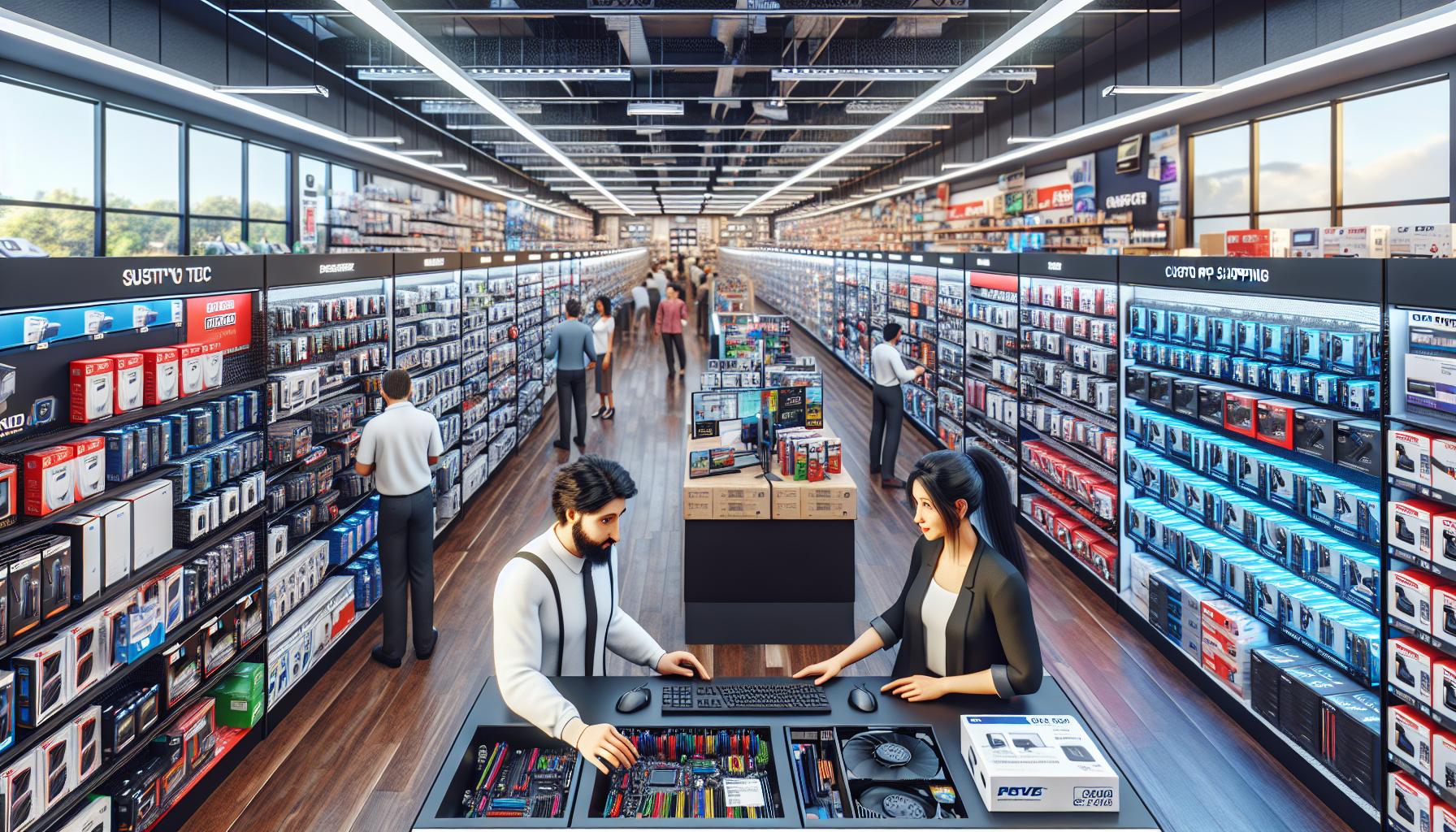
As a long-time tech enthusiast, I’ve watched Fry’s Electronics transform from a small Silicon Valley computer store into a retail giant that shaped the DIY computing landscape. Founded in 1985, Fry’s became synonymous with affordable computers, components and electronics for both casual users and tech professionals.
I remember walking through the themed aisles of Fry’s massive warehouses, where you could find everything from motherboards and graphics cards to complete gaming rigs. The retailer’s unique approach to computer sales, offering both individual parts and pre-built systems, made it a go-to destination for anyone looking to build or upgrade their PC. While Fry’s closed its doors in 2021, its impact on computer retail and DIY culture continues to influence how we shop for tech today.
Key Takeaways
- Fry’s Electronics operated from 1985 to 2021, growing from a single Silicon Valley store to 34 locations across 9 states and becoming a major force in computer retail
- The retailer was known for its themed store designs, extensive inventory of over 50,000 tech products, and comprehensive selection of computer components and systems
- Fry’s unique business model combined family ownership, aggressive price matching, technical expertise, and immersive shopping experiences that set new standards for electronics retail
- Key factors in Fry’s closure included competition from Amazon, shifts toward mobile computing, COVID-19 supply chain issues, and outdated inventory systems
- The company’s legacy lives on through its influence on computer retail practices, including comprehensive price matching, extensive product selection, and technical support services
Frys Computers
Fry’s Electronics transformed from a single Silicon Valley store in 1985 into a 34-location powerhouse across 9 states by 2019. Each store featured elaborate themes, such as ancient Egypt in Campbell CA or wild west decor in Palo Alto CA, creating distinctive shopping environments spanning up to 50,000 square feet.
The company’s growth paralleled the PC revolution of the 1990s, offering an unmatched selection of components:
- Custom-built desktop parts including motherboards, CPUs, RAM modules
- Complete computer systems from major manufacturers
- Software packages for both home users and businesses
- Gaming peripherals and entertainment systems
| Year | Milestone | Impact |
|---|---|---|
| 1985 | First store opens in Sunnyvale, CA | Established DIY computer retail model |
| 1996 | Expanded to 17 locations | Became major West Coast tech retailer |
| 2019 | Peak at 34 stores | $2.4 billion annual revenue |
| 2021 | Complete closure | 31 stores shuttered simultaneously |
Multiple factors contributed to Fry’s decline:
- Amazon’s rise in online electronics retail
- Shift toward mobile computing devices
- Reduced demand for custom PC components
- Supply chain disruptions during COVID-19
- Outdated inventory management systems
The final years saw empty shelves, consignment-only merchandise and declining customer service quality. On February 24, 2021, Fry’s Electronics announced immediate closure of all remaining locations, ending its 36-year legacy in consumer electronics retail.
A Legacy of Computer Retail Excellence

Fry’s Electronics established a distinctive retail model that reshaped computer shopping in America. The company’s approach combined theatrical store designs with comprehensive tech offerings to create an unmatched shopping destination.
Store Atmosphere and Shopping Experience
Each Fry’s location featured unique thematic elements that transformed computer shopping into an immersive experience. The San Jose store showcased wild west motifs while the Burbank location displayed 1950s sci-fi elements with UFOs suspended from ceilings. Store layouts incorporated wide aisles segmented into specialized zones for processors, motherboards, peripherals, software, complete systems. The checkout process included detailed component verification stations staffed by technical associates who confirmed compatibility before purchase.
Tech Product Selection and Pricing
Fry’s maintained an extensive inventory of over 50,000 tech products across multiple categories:
- Computer Components
- 300+ motherboard models
- 200+ processor options
- 150+ graphics card variations
- 400+ RAM configurations
- Complete Systems
- Pre-built desktop computers
- Gaming laptops
- Workstations
- Server solutions
| Product Category | Average Items Stocked | Price Match Guarantee |
|---|---|---|
| Components | 2,000+ | Yes |
| Systems | 500+ | Yes |
| Peripherals | 1,500+ | Yes |
| Software | 1,000+ | Yes |
The pricing strategy incorporated aggressive markdowns on loss leaders like memory modules paired with competitive margins on high-end components. Daily price matching against major competitors ensured customers received optimal value across product categories.
The Unique Business Model

Fry’s Electronics operated on a distinctive retail model that combined family ownership with aggressive expansion strategies. The company maintained direct control over its operations while scaling across multiple states.
Family-Owned Operations
The Fry family maintained complete ownership of Fry’s Electronics from its inception in 1985 through its closure in 2021. Brothers John Randy Dave Kathryn Fry established a management structure where each sibling oversaw specific aspects of the business: John handled operations Dave managed merchandising Randy focused on computers Kathryn directed marketing. The family-centric leadership enabled quick decision-making rapid inventory adjustments store theme implementations without shareholder interference.
Regional Market Dominance
Fry’s Electronics established strategic strongholds in tech-centric markets across nine states. The company positioned 34 stores in key locations:
- 17 stores in California including 8 in Silicon Valley
- 8 stores in Texas targeting Austin Dallas Houston tech corridors
- 2 stores each in Arizona Oregon Washington
- Single locations in Nevada Illinois Indiana Georgia
- Build efficient supply chains
- Tailor inventory to local tech industry needs
- Maintain competitive pricing through bulk purchasing
- Create market-specific promotional strategies
- Develop strong relationships with local suppliers manufacturers
| Region | Number of Stores | Peak Market Share |
|---|---|---|
| California | 17 | 45% |
| Texas | 8 | 35% |
| Pacific Northwest | 5 | 28% |
| Other States | 4 | 15% |
Impact on Computer Retail Industry

Fry’s Electronics reshaped computer retail through its unique combination of extensive product selection, competitive pricing, and immersive shopping environments. The company’s influence extended beyond its own operations, setting new standards for tech retail nationwide.
Competition with Other Tech Retailers
Fry’s Electronics created significant competitive pressure in the computer retail space through several key strategies:
- Price matching policies forced competitors like Best Buy, Circuit City, and CompUSA to adjust their pricing models
- In-store tech support services prompted other retailers to expand their service offerings
- Comprehensive product selection pushed competitors to diversify their inventory beyond basic consumer electronics
- Strategic store locations in tech hubs challenged established retailers’ market dominance
- Bulk purchasing agreements with manufacturers enabled below-market pricing on popular items
| Market Impact Area | Pre-Fry’s Standard | Fry’s Innovation |
|---|---|---|
| Product Selection | 5,000-10,000 items | 50,000+ items |
| Price Match Policy | Limited matches | Comprehensive matching |
| Store Size | 15,000-30,000 sq ft | 50,000+ sq ft |
| Tech Support | Basic assistance | Full-service repair |
Customer Service Standards
Fry’s established distinctive customer service practices that influenced industry expectations:
- Technical expertise requirements for sales staff in specialized departments
- On-site repair services with same-day turnaround options
- Extended return policies for computer components up to 30 days
- Dedicated build stations for custom PC assembly assistance
- Component compatibility verification before purchase
- Post-purchase technical support through dedicated help desks
These standards transformed from competitive advantages into industry expectations, with many retailers adopting similar practices to remain competitive in the computer retail market.
The End of an Era
The closure of Fry’s Electronics on February 24, 2021 marked the final chapter of a 36-year legacy in consumer electronics retail. This abrupt shutdown left tech enthusiasts reminiscing about the unique shopping experience that defined an era of computer retail.
Factors Leading to Closure
Multiple critical factors contributed to Fry’s downfall:
- E-commerce Competition
- Amazon’s market dominance with same-day delivery options
- Competitive online pricing from digital retailers
- Shift in consumer shopping habits toward digital platforms
- Supply Chain Disruptions
- COVID-19 pandemic impacts on inventory management
- Reduced product availability from manufacturers
- Increased shipping costs affecting profit margins
- Operational Challenges
- Outdated inventory management systems
- Consignment-based business model limitations
- Rising operational costs across 34 locations
- Market Evolution
- Decreased demand for custom PC components
- Shift toward mobile computing devices
- Reduced need for in-person technical support
| Year | Key Business Metrics | Impact |
|---|---|---|
| 2019 | Store Count | 34 locations |
| 2020 | Empty Shelf Rate | 70% inventory reduction |
| 2021 | Active Locations | 0 (complete closure) |
| 2021 | Employee Count | 2,800 jobs eliminated |
The combination of these factors created unsustainable business conditions, leading to empty shelves across locations. Suppliers began pulling inventory due to payment concerns, creating a visible decline in product availability. The final months saw stores operating with minimal stock, deteriorating customer service standards, and declining foot traffic.
Tech Enthusiasts
Fry’s Electronics’ journey from a local Silicon Valley store to a nationwide tech retail giant represents a remarkable chapter in American retail history. I’ve witnessed how their innovative approach to computer retail transformed the shopping experience for tech enthusiasts across generations.
While the company’s closure in 2021 marked the end of an era the legacy of Fry’s continues to influence modern tech retail. Their commitment to extensive product selection competitive pricing and themed store designs set industry standards that many retailers follow today.
The story of Fry’s reminds us that even the most successful businesses must adapt to changing market conditions and consumer preferences. As we move forward in this digital age I’ll remember Fry’s Electronics as a pioneer that helped shape the way we shop for technology.








